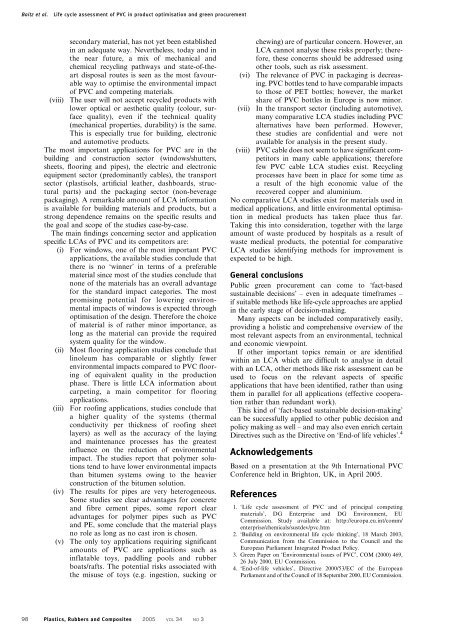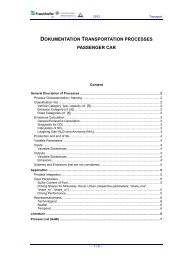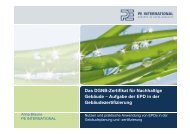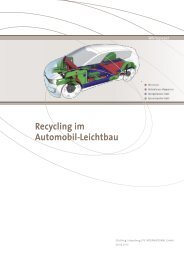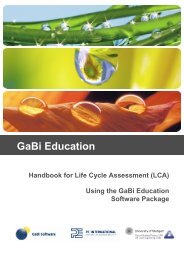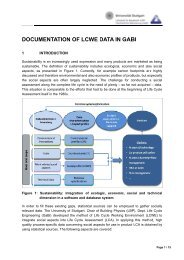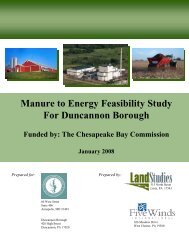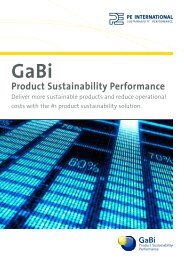here - GaBi Software
here - GaBi Software
here - GaBi Software
Create successful ePaper yourself
Turn your PDF publications into a flip-book with our unique Google optimized e-Paper software.
Baitz et al. Life cycle assessment of PVC in product optimisation and green procurement<br />
secondary material, has not yet been established<br />
in an adequate way. Nevertheless, today and in<br />
the near future, a mix of mechanical and<br />
chemical recycling pathways and state-of-theart<br />
disposal routes is seen as the most favourable<br />
way to optimise the environmental impact<br />
of PVC and competing materials.<br />
(viii) The user will not accept recycled products with<br />
lower optical or aesthetic quality (colour, surface<br />
quality), even if the technical quality<br />
(mechanical properties, durability) is the same.<br />
This is especially true for building, electronic<br />
and automotive products.<br />
The most important applications for PVC are in the<br />
building and construction sector (windows/shutters,<br />
sheets, flooring and pipes), the electric and electronic<br />
equipment sector (predominantly cables), the transport<br />
sector (plastisols, artificial leather, dashboards, structural<br />
parts) and the packaging sector (non-beverage<br />
packaging). A remarkable amount of LCA information<br />
is available for building materials and products, but a<br />
strong dependence remains on the specific results and<br />
the goal and scope of the studies case-by-case.<br />
The main findings concerning sector and application<br />
specific LCAs of PVC and its competitors are:<br />
(i) For windows, one of the most important PVC<br />
applications, the available studies conclude that<br />
t<strong>here</strong> is no ‘winner’ in terms of a preferable<br />
material since most of the studies conclude that<br />
none of the materials has an overall advantage<br />
for the standard impact categories. The most<br />
promising potential for lowering environmental<br />
impacts of windows is expected through<br />
optimisation of the design. T<strong>here</strong>fore the choice<br />
of material is of rather minor importance, as<br />
long as the material can provide the required<br />
system quality for the window.<br />
(ii) Most flooring application studies conclude that<br />
linoleum has comparable or slightly fewer<br />
environmental impacts compared to PVC flooring<br />
of equivalent quality in the production<br />
phase. T<strong>here</strong> is little LCA information about<br />
carpeting, a main competitor for flooring<br />
applications.<br />
(iii) For roofing applications, studies conclude that<br />
a higher quality of the systems (thermal<br />
conductivity per thickness of roofing sheet<br />
layers) as well as the accuracy of the laying<br />
and maintenance processes has the greatest<br />
influence on the reduction of environmental<br />
impact. The studies report that polymer solutions<br />
tend to have lower environmental impacts<br />
than bitumen systems owing to the heavier<br />
construction of the bitumen solution.<br />
(iv) The results for pipes are very heterogeneous.<br />
Some studies see clear advantages for concrete<br />
and fibre cement pipes, some report clear<br />
advantages for polymer pipes such as PVC<br />
and PE, some conclude that the material plays<br />
no role as long as no cast iron is chosen.<br />
(v) The only toy applications requiring significant<br />
amounts of PVC are applications such as<br />
inflatable toys, paddling pools and rubber<br />
boats/rafts. The potential risks associated with<br />
the misuse of toys (e.g. ingestion, sucking or<br />
98 Plastics, Rubbers and Composites 2005 VOL 34 NO 3<br />
chewing) are of particular concern. However, an<br />
LCA cannot analyse these risks properly; t<strong>here</strong>fore,<br />
these concerns should be addressed using<br />
other tools, such as risk assessment.<br />
(vi) The relevance of PVC in packaging is decreasing.<br />
PVC bottles tend to have comparable impacts<br />
to those of PET bottles; however, the market<br />
share of PVC bottles in Europe is now minor.<br />
(vii) In the transport sector (including automotive),<br />
many comparative LCA studies including PVC<br />
alternatives have been performed. However,<br />
these studies are confidential and were not<br />
available for analysis in the present study.<br />
(viii) PVC cable does not seem to have significant competitors<br />
in many cable applications; t<strong>here</strong>fore<br />
few PVC cable LCA studies exist. Recycling<br />
processes have been in place for some time as<br />
a result of the high economic value of the<br />
recovered copper and aluminium.<br />
No comparative LCA studies exist for materials used in<br />
medical applications, and little environmental optimisation<br />
in medical products has taken place thus far.<br />
Taking this into consideration, together with the large<br />
amount of waste produced by hospitals as a result of<br />
waste medical products, the potential for comparative<br />
LCA studies identifying methods for improvement is<br />
expected to be high.<br />
General conclusions<br />
Public green procurement can come to ‘fact-based<br />
sustainable decisions’ – even in adequate timeframes –<br />
if suitable methods like life-cycle approaches are applied<br />
in the early stage of decision-making.<br />
Many aspects can be included comparatively easily,<br />
providing a holistic and comprehensive overview of the<br />
most relevant aspects from an environmental, technical<br />
and economic viewpoint.<br />
If other important topics remain or are identified<br />
within an LCA which are difficult to analyse in detail<br />
with an LCA, other methods like risk assessment can be<br />
used to focus on the relevant aspects of specific<br />
applications that have been identified, rather than using<br />
them in parallel for all applications (effective cooperation<br />
rather than redundant work).<br />
This kind of ‘fact-based sustainable decision-making’<br />
can be successfully applied to other public decision and<br />
policy making as well – and may also even enrich certain<br />
Directives such as the Directive on ‘End-of life vehicles’. 4<br />
Acknowledgements<br />
Based on a presentation at the 9th International PVC<br />
Conference held in Brighton, UK, in April 2005.<br />
References<br />
1. ‘Life cycle assessment of PVC and of principal competing<br />
materials’, DG Enterprise and DG Environment, EU<br />
Commission. Study available at: http://europa.eu.int/comm/<br />
enterprise/chemicals/sustdev/pvc.htm<br />
2. ‘Building on environmental life cycle thinking’, 18 March 2003,<br />
Communication from the Commission to the Council and the<br />
European Parliament Integrated Product Policy.<br />
3. Green Paper on ‘Environmental issues of PVC’, COM (2000) 469,<br />
26 July 2000, EU Commission.<br />
4. ‘End-of-life vehicles’, Directive 2000/53/EC of the European<br />
Parliament and of the Council of 18 September 2000, EU Commission.


